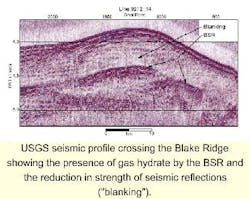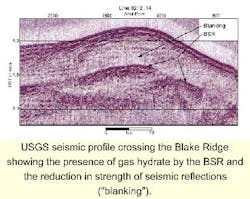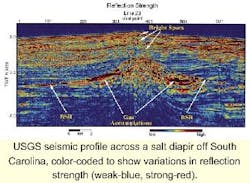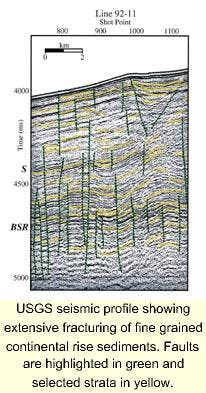Seismic reflections identify finite differences in gas hydrate resources
Gas hydrate is a gas-bearing, ice-like crystalline solid. The substance's build ing blocks consist of a gas molecule (generally methane) sur-rounded by a cage of water molecules. The total amount of methane in hydrate in the world is immense - the most recent speculative estimate centers on values of 21x1015 cu meters. Thus, it may represent a future energy resource. This estimate was presented by Keith Kvenvolden at the International Symposium on Methane Hydrates, Resources in the Near Future, sponsor ed by Japanese National Oil Company (Tokyo, October, 1998).
But, as with any natural resource, there is a need to find naturally occurring concentrations in order to effectively extract gas. We need to answer four basic questions:
- Do methane hydrate concentrations suitable for methane extraction exist?
- How can we recognize these concentrations?
- Where are concentrations located?
- What processes control methane hydrate concentrations?
Gas hydrate occurs naturally at the pressure/ temperature/chemical conditions that are present within ocean floor sediments at water depths greater than about 500 meters. The gas hydrate stability zone (GHSZ) extends from the sea bottom downward to a depth where the natural increase in temperature causes the hydrate to melt (dissociate), even though the downward pressure increase is working to increase gas hydrate stability.
Thus, the base of the GHSZ tends to parallel the seafloor at any given water depth (pressure), because the sub-seafloor isotherms (depths of constant temperature) generally parallel the seafloor. The layer at which gas hydrate is stable commonly extends from the sea floor to several hundred meters below it. The gas in most gas hydrates is methane, generated by bacteria in the sediments. In some cases, it can be higher carbon-number, thermogenic hydrocarbon gases that rise from greater depths.
Finding hydrates
Seismic data provides a means to recognize gas hydrate in the sediments, because the presence of gas hydrate and the free gas that is commonly trapped beneath it, produce noticeable effects on transmitted and reflected sound that is imaged on seismic reflection records.
Precisely how gas is trapped beneath the GHSZ is not clearly understood at present. The gas seal may result from bubble effects, a thin zone of high gas hydrate content, etc., but gas definitely is trapped there. Pure gas hydrate has a compressional-wave acoustic velocity about twice that of normal seafloor sediments, so the addition of gas hydrate increases the average velocity of the sediments in which it occurs.
Conversely, the presence of free gas trapped beneath the GHSZ dramatically lowers acoustic velocity. The most obvious effect of gas hydrate in sediment is the very strong seismic reflection or set of reflections caused by the very large velocity contrast between gas hydrate-bearing and free gas-bearing sediments at the base of the GHSZ.
This strong reflection at the gas hydrate-free gas boundary tends to parallel the seafloor (approximately following a depth level where temperature is constant) and so the reflection has become known as the bottom simulating reflection (BSR). The BSR does not always parallel the seafloor, because isotherms can be distorted, and the stability of gas hydrate is also influenced by the chemistry of the gases and interstitial water.
Blanking phenomenon
A phenomenon known as blanking, the weakening of reflection amplitudes of the acoustic layers where gas hydrate is concentrated, is also common. One explanation that has been suggested for these weaker reflections is that they may represent the normal reflection strengths for sedimentary layers that have no gas and that all stronger reflections represent the effect of variations of gas in the layers. This seems unlikely though, because we frequently see lateral variations in blanking in the GHSZ that seem to correlate to variations in gas hydrate concentrations.
The acoustic layering that we see in seismic profiles as caused primarily by variations in porosity of adjacent layers, cause variations in acoustic velocity. These velocity variations generate the reflections and control their strength.
We infer that blanking results from the favored accumulation of gas hydrate in the more porous layers of the sediment, which preferentially increases the velocity of the more porous, initially acoustically slower layers. Thus, the velocity contrasts between adjacent sedimentary layers are decreased. As a result, the reflection strengths in the sediment are reduced.
Blanking is likely to be important because it seems to tell us about the variations of hydrate concentration within the gas hydrate zone, not just about conditions at the boundary of the zone, as the BSR does. Other approaches to examining the velocity and other acoustic parameters within the zone of gas hydrate stability may also become important such as using long hydrophone streamers, ocean bottom seismometers, deep-towed seismic systems, etc.
Thus, by using seismic data, we are developing some ways to identify gas hydrate distribution in seafloor sediments. Now we can proceed to the questions: where do we find concentrations of gas hydrate and what consistent patterns appear which can suggest a process for concentration?
Formation patterns
The consistent pattern we see in the figures and elsewhere is that gas hydrate concentrations commonly appear above sites where gas has become trapped below the GHSZ. Such traps can take several forms. The simplest situation is where the base of the GHSZ, which follows the shape of the seafloor, forms a broad arch or dome shape and acting as a seal, forms a gas trap (see figure).
The Blake Ridge (western Atlantic off South Carolina) itself is just a sediment pile, formed at a confluence of bottom currents, but its shape is important to create the gas-trapping configuration at the base of the GHSZ. We suppose that the trap at the base of the GHSZ provides a reservoir of gas, that this gas slowly migrates upward into the GHSZ by diffusion and through fractures, and that this process leads to dense concentrations of gas hydrate.
At places like this, where sediment is accumulating, the GHSZ maintains a constant thickness as the seafloor builds up, requiring that gas hydrate continually dissociate at the base of the GHSZ, releasing gas. This released gas is supplied to the trap and becomes available to be recycled back up into the gas hydrate zone.
Meanwhile, bacteria continue to generate new gas that enters this system of gas recycling and concentration. The presence of gas and hydrate has been confirmed by three holes drilled near the ridge crest during Ocean Drilling Program (ODP) leg 164 in 1995. The rates at which the system works will become one of the key questions in research.
Concentration by disruption
Sometimes the gas traps that encourage gas hydrate concentration are formed by disruptions of the normal thermal/chemical field in the sediments, a phenomenon clearly seen above salt domes. Salt has higher heat conductivity than sediment, so a warm spot will exist above a salt dome. Furthermore, the ions dissolved out of the salt act as inhibitors (antifreeze) to gas hydrate, just as salt lowers the freezing temperature of water ice.
This double effect of chemical inhibition and disturbance of the thermal structure causes the base of the GHSZ to be warped upward above a salt dome, creating a gas trap (see figure). The strongest reflections (dark red) come from the levels where gas is trapped beneath the gas hydrate, providing strong acoustic contrasts between high-porosity, gas-bearing strata and low-porosity, non-gas-bearing strata. These strong reflections appear just under the BSR.
The BSR certainly does not fulfill its name by "simulating" the seafloor because of the strong influence of variable temperature and chemistry, but it does show us where the base of gas hydrate is located. Above the BSR are zones of very low reflection amplitude (blue) that indicate where the gas hydrate is concentrated. On the left of the profile, the top of concentrated gas hydrate follows a stratum, but on the right, it cuts across strata, showing that sedimentary layers do not necessarily control the concentration of gas hydrate. Studies such as this may show us where gas hydrate is concentrated and allow us to infer the processes that create the concentrations.
Best deposits
Where are the best places to look for gas hydrate deposits for methane extraction? The continental slopes seem to have the greatest concentrations of gas hydrate because they contain higher concentrations of organic matter for methane generation by bacteria and have greater rates of sediment accumulation, which buries the organic matter and allows bacterial decomposition to form gas.
The shallower depths of the upper slopes allow the greatest concentrations of methane compared to conventional gas traps. From the minimum depth of hydrate stability down to total depths of about 1,600 meters, gas is held in hydrate in concentrations greater than in conventional traps.
This happens because gas molecules are held closer together in the crystal lattice than they would be by simple pressurization. However, the maximum concentration of gas in hydrate is essentially fixed, so at greater depths, free gas reservoirs will be more concentrated as a result of the higher pressure.
The fixed concentration of gas in gas hydrate also means that shallower gas hydrate deposits will release gas that will expand more and fill a greater proportion of the pore volume than comparable deposits at greater depths (at greater pressures). Stated differently, a 5% pore concentration of gas hydrate at 1,000 meters will provide the same gas expansion as a 15% concentration at 3,000 meters.
Therefore, there is greater likelihood at shallow depths of exceeding the minimum limit of gas volume needed to generate spontaneous gas flow. Both the concentration factor at shallow depths and the expansion considerations suggest that the shallower part of the gas hydrate range may be more favorable for gas extraction - perhaps in the 1,000-2,000 meter range.
Hydrate extraction
We expect that methane will be extracted from hydrate by using a combination of:
- Depressurization (perhaps primarily)
- Warming (perhaps using warm fluids from deeper in the sediments)
- Chemical inhibitors to initiate dissociation at critical spots (used judiciously).
One concern about extraction on the continental slopes is that sediments there often are moderately fine-grained muds that might have poor permeability. It is early in our studies to make a blanket statement, but the presence of extensive fractures in the gas hydrate zone, which could provide permeability, is common even in tectonically inactive regions like the United States' eastern continental margin.
Speculatively, this might result from overpressures developed at the base of the GHSZ by dissociation of gas hydrate beneath the seal. Major seafloor blowouts have taken place in that region and have been identified elsewhere in the world and blamed on gas hydrate-related processes. However, smaller scale, more constant disruption may be more important to provide fracture permeability and allow extraction of gas.
Future resource
It is early to predict whether gas hydrate will become an energy resource. The issues are geological, engineering, and political/economic.
- Geological issues: How do we find producible concentrations of gas hydrate and locate them? We seem to be making progress.
- Engineering in the oil business has accomplished amazing things and this new challenge does not seem so difficult to solve, if we are willing to apply the resources necessary.
- Politics and economics: These two seem to be interrelated. Is a country energy-poor and is it a considerable distance from supplies so that expenses are high? Are its energy needs rapidly escalating for economic development? Is it bordered by an unfriendly neighbor, who precludes efficient energy transport by pipeline? Does it desire more energy independence for security reasons? Do alternative energy approaches (e.g. nuclear) look less appealing than formerly?
Such political/economic factors are partially driving interest in gas hydrate in Asia at present. Of course, the cost of energy is the overwhelming factor, and the only safe prediction is that it will change. The use of gas hydrate could change the geopolitics of energy, but it is far to soon to speculate about that.
Where are we now? We are at the beginning of studies that are promising and that will allow us to properly assess the nature and potential of the gas hydrate resource. To quote sources at Shell International: "There seem to be no show stoppers in the development of gas hydrate as an energy resource."
Acknowledgements
The author would like to thank the U.S. Department of Energy and the Federal Energy Technology Center for their support of the U.S. Geological Survey's effort to collect seismic data designed for the gas hydrate zone. Thanks also to Michael Taylor and Christopher Anton for seismic processing and interpretation.



